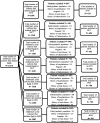Emergence of Extended spectrum β-lactamase (ESBL) and carbapenemase producing Escherichia coli (E. coli) in mid-stream urine cultures of patients presenting in outpatient department of tertiary care hospital with uncomplicated cystitis (2016-2022): A retrospective analysis of Laboratory data
- PMID: 39867801
- PMCID: PMC11755285
- DOI: 10.12669/pjms.41.1.3379
Emergence of Extended spectrum β-lactamase (ESBL) and carbapenemase producing Escherichia coli (E. coli) in mid-stream urine cultures of patients presenting in outpatient department of tertiary care hospital with uncomplicated cystitis (2016-2022): A retrospective analysis of Laboratory data
Abstract
Objective: To determine the prevalence of antimicrobial resistance (AMR) in E. coli isolated from urine cultures of patients with uncomplicated cystitis in Pakistan. Another objective was to analyze and compare the resistance rates of E. coli to specific antibiotics, conducting a year-by-year evaluation of these rates to identify trends and changes over the past seven years.
Methods: Retrospective analysis of susceptibility data of E. coli isolated from midstream urine culture samples of patients presenting in outpatient department with uncomplicated cystitis, from January 2016 to December 2022 in the section of Microbiology, Liaquat University of Medical and Health Sciences was done. All the demographic data, clinical information and susceptibility results were obtained from laboratory data base. All the cultures were performed on CLED agar and E. coli was identified using biochemical tests, susceptibility test was performed by disk diffusion method and clavulanate inhibition test for analysis of extended spectrum β-lactamase (ESBL) was performed.
Results: A total of 5169 patients with uncomplicated cystitis with no history of renal disease, pregnancy, hospitalization, catheterization and no elderly or pediatric population were included, 76% of which were of females. Mean age was 37 ±11 years Rising trends of resistance were observed in ampicillin (86.3%-95.3%), cotrimoxazole (12.8-48.6%), ciprofloxacin (57.3-81.6%) and low rates of resistance were seen in fosfomycin (0.57-2.96%), nitrofurantoin (0.72-2.96%) and amikacin (2.09-3.15%). Presence of ESBL and emerging resistance to ceftriaxone (15.7-48.7%), piperacillin/tazobactam (0-4.84%) and carbapenems (0-0.39%) was observed.
Conclusion: The national guidelines offer an empirical treatment regimen for patients with uncomplicated cystitis. However, regional variations in antimicrobial resistance (AMR) complicate adherence to these guidelines. Our study supports the use of fosfomycin and nitrofurantoin in management of uncomplicated cystitis, However, ongoing annual regional surveillance is essential to keep clinicians informed about the latest trends in AMR.
Keywords: Antimicrobial resistance; E. coli; Uncomplicated cystitis; Urinary tract Infection; empirical therapy.
Copyright: © Pakistan Journal of Medical Sciences.
Figures
Similar articles
-
Antimicrobial susceptibilities of urinary extended-spectrum beta-lactamase-producing Escherichia coli and Klebsiella pneumoniae to fosfomycin and nitrofurantoin in a teaching hospital in Taiwan.J Microbiol Immunol Infect. 2011 Oct;44(5):364-8. doi: 10.1016/j.jmii.2010.08.012. Epub 2011 Jan 20. J Microbiol Immunol Infect. 2011. PMID: 21524974
-
Community-Acquired Uropathogenic Escherichia coli, Antimicrobial Susceptibility, and Extended-Spectrum Beta-Lactamase Detection.MEDICC Rev. 2022 May 16;24(2):20-25. doi: 10.37757/mr2022.v24.n2.2. MEDICC Rev. 2022. PMID: 35648059
-
Uropathogen distribution and antimicrobial susceptibility in uncomplicated cystitis in Belgium, a high antibiotics prescribing country: 20-year surveillance.Eur J Clin Microbiol Infect Dis. 2017 Jan;36(1):105-113. doi: 10.1007/s10096-016-2776-8. Epub 2016 Sep 17. Eur J Clin Microbiol Infect Dis. 2017. PMID: 27639858
-
Treatment of urinary tract infections in the era of antimicrobial resistance and new antimicrobial agents.Postgrad Med. 2020 Apr;132(3):234-250. doi: 10.1080/00325481.2019.1680052. Epub 2019 Oct 24. Postgrad Med. 2020. PMID: 31608743 Review.
-
An update on the management of urinary tract infections in the era of antimicrobial resistance.Postgrad Med. 2017 Mar;129(2):242-258. doi: 10.1080/00325481.2017.1246055. Epub 2016 Oct 21. Postgrad Med. 2017. PMID: 27712137 Review.
Cited by
-
High ceftazidime-avibactam resistance rate in carbapenem-resistant gram-negative organisms in Pakistan's pediatric population.Pak J Med Sci. 2025 Mar;41(3):788-791. doi: 10.12669/pjms.41.3.9978. Pak J Med Sci. 2025. PMID: 40103864 Free PMC article.
References
-
- Larramendy S, Deglaire V, Dusollier P, Fournier JP, Caillon J, Beaudeau F, et al. Risk factors of extended-spectrum beta-lactamases-producing Escherichia coli community acquired urinary tract infections: a systematic review. Infect Drug Resist. 2020;13:3945–3955. doi: 10.2147/IDR.S269033. - PMC - PubMed
-
- The Infectious Disease Society of Pakistan (IDSP) 2019. Guidelines for antimicrobial use. [Accessed on February 1, 2020]. Website: https://www.mmidsp.com/wp-content/uploads/2019/09/Guidelines-for-Antimic... .
LinkOut - more resources
Full Text Sources
Miscellaneous


